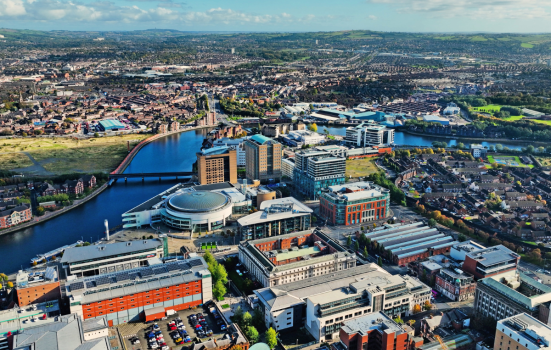Arts Council of Northern Ireland says increase in organisations leveraging investment from new sources is “positive news” amid “pressured and complicated funding picture”.

Ballygally View Images
Arts Council of Northern Ireland’s (ACNI) regularly funded organisations are increasing the income they generate from other sources, according to newly released data.
ACNI’s most recent Annual Funding Survey received data from the 95 small, medium and large scale arts organisations that received regular funding in 2022/23.
It found income from trusts and foundations grew by 20% year-on-year. The £3.6m far exceeds the £338,425 organisations collectively generated from trusts and foundations in 2019/20, the last pre-pandemic year.
READ MORE:
- Calls for increased sector investment in Northern Ireland
- Northern Ireland arts organisations lose regular funding
ACNI called the development “positive news” amid a “pressurised and complicated funding picture”. Earlier this year, Northern Ireland’s Department for Communities cut ACNI’s budget by 5%, to help bridge a funding gap in excess of £111m.
The move led to organisations losing their regular funding and ACNI’s leadership team saying their funding is “simply not enough” to meet their objectives.
In 2022/23, public sector income represented 31% of all income for regularly funded organisations, a fall of 6% when compared to the year before.
In comparison, earned income represented 43% of all income, an increase of 12%. ACNI says this growth was driven by increased box-office sales in large-scale organisations.
Karly Greene, ACNI Director of Strategic Development and Partnerships, commented: “Looking at this year’s data we can see that, despite the enormous challenges, some arts organisations receiving investment from the Arts Council have been able to diversify their income from other sources in order to sustain their activities”.
"It’s clear, that with a much-needed increase in public sector investment in the arts, Northern Ireland has an opportunity to yield even greater social and economic return from the arts, which will benefit jobs, communities and help to attract future inward investment.”
Rising running costs
ACNI’s Annual Funding Survey also reiterated the impact of increasing costs. Regularly-funded organisations collectively saw their core running costs increase by 16% in 2022/23 compared to the previous 12 months.
Combined core running costs are now 43% higher than before the pandemic.
Salary costs in 2022/23 comprised of two thirds of all core costs, totalling £23.4m, a figure 50% higher than in the last pre-pandemic year.
Rent and rates increased by 6% year-on-year, light and heating by 50% and printing costs by 34%. Travel, accommodation and subsistence costs saw the largest jump, a 133% year-on-year increase.
As the reporting period for the survey was 1 April 2022 to 31 March 2023, many regularly funding organisations are likely to have experienced continued rising costs through the remainder of 2023.
Post-Covid recovery continues
Elsewhere, ACNI’s Annual Funding Survey found programming and audience levels are yet to return to pre-pandemic levels.
Face-to-face engagement levels in the form of physical performances, participation, exhibitions and cinema screenings doubled to over 60,000 but remained 13% down on 2019/20.
In contrast to the growth in physical activity, the development of online products slowed, with 38% fewer organisations investing in 2022/23 compared to the year prior. Income from online sources represented less than 1% of total earned income.
Overall engagement, consisting of combined known and estimated audiences, stood at 5.67m, a year-on-year increase of around 67%, but remained 21% lower than 2019/20.
ACNI found its regularly funded organisations’ overall workforce was back to pre-Covid levels, having grown by 29% last year.
The greatest growth in employment was in part-time and full-time artists on fixed-term contract basis, while permanent full-time positions remained 6% lower than in 2019/20.
But ACNI said it found evidence volunteers are being recruited to take on previously paid roles so that organisations can maintain service provision.
In some cases, organisations are being run by a board of volunteers, rather than paid staff.




